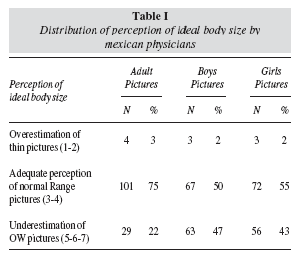My SciELO
Services on Demand
Journal
Article
Indicators
-
 Cited by SciELO
Cited by SciELO -
 Access statistics
Access statistics
Related links
-
 Cited by Google
Cited by Google -
 Similars in
SciELO
Similars in
SciELO -
 Similars in Google
Similars in Google
Share
Nutrición Hospitalaria
On-line version ISSN 1699-5198Print version ISSN 0212-1611
Nutr. Hosp. vol.23 n.1 Madrid Jan./Feb. 2008
CARTA AL DIRECTOR
Mexican physicians' bias towards the obese child
Actitud de médicos mexicanos hacia el niño con obesidad
Dear Dr. Culebras:
High prevalence of childhood obesity was recently found among 8-13 years old children,1 and in the northwestern Mexico-US border the prevalence of obesity is higher than the national level.2 It has also been reported in industrialized countries that overweight (OW) and obesity have been stigmatizing conditions since medieval times.3, 4 Negative attitudes towards obesity have been linked to incorrect beliefs about the causes of weight gain and the responsibilities of being OW to the person and their family. The purpose of this study was to assess the association between the estimation of body size and the attitudes towards obese children among Mexican physicians. From four outpatient clinics at the three main public health institutions from Tijuana and Ensenada all physicians working during the morning shift were asked to participate. Subjects were given a questionnaire with 13 questions including attitudes toward the obese child (six about features of the obese child, 4 about caring for the obese child and three on beliefs about the effect of self-control on prevention and treatment of obesity), self-reported weightand height, self-estimation of body size and estimation of ideal body size for adults and children. Subjects were asked to circle the ordinal scale that best represented their agreement with a given statement: indicating whether they strongly agreed (number 1), agreed (number 2), were uncertain (numbers 3 to 5), disagreed, (number 6), or strongly disagreed (number 7) with each statement. Self-response questionnaires also include the estimation of healthy body size for adults and boys and girls 6- to 10-years of age, according to a modified Stunkard pictogram.5, 6 Descriptive univariate statistics including ranges and means and bivariate analyses such as Pearson r and χ2 test of associations were computed. Seventy eight percent of males (n = 93) and 61% of females (n = 42) physicians were either OW or obese. The average age was 44 years (males) and 40 years (females). Forty five percent of them disagree with the statements related to negative features of the obese child, and 7% disagree with the statements regarding childhood obesity as the result of lack of willpower. Seventy three percent have strong beliefs placing responsibility on the obese child about his/her obesity problem. Perception of ideal body size is shown in table I. Despite of being a group of physicians with high prevalence of OW and obesity, those who underestimate the OW of a girl's drawing have stronger [OR: 1.45 (1.0-2.1)] negative attitudes toward the obese child, and those who underestimate the OW drawings of a boy [(OR: 2.5 (1.06-6.06)] and of a girl [(OR: 2.73 (1.1-6.8)] have stronger beliefs about the personal responsibility of the obese child (table II). The results of this study show a high underestimation of OW and misconception of the causes of obesity among Mexican physicians with high prevalence of OW and obesity. The underestimation was associated to higher misconceptions about the causes of obesity and with stronger negative attitudes toward the obese child. Underestimation of OW may prevent the detection of obesity, and negative attitudes toward obese children will increase stigmatization and diminish the quality of life for obese children. Reducing stigmatization towards obese children among physicians and other health care professional involved on clinical nutrition7 should be part of a comprehensive public health approach to the obesity epidemic.
A. Jiménez-Cruz*, M. Bacardí-Gascón*, A. Armendáriz-Anguiano,
B. Márquez Ibáñez, M. Sepúlveda-Romo y I. C. Revelles Rojas
*Postgrado en Nutrición. Universidad Autónoma de Baja California. Tijuana. México.
References
1. Briz Hidalgo FJ, Cos Blanco AI y Amate Garrido AM. Prevalencia de obesidad infantil en Ceuta. Estudio PONCE 2005. Nutr Hosp 2007; 22(4):471-77.
2. Jiménez-Cruz A, Bacardí-Gascón M. Prevalencia de sobrepeso y sensación de hambre en niños mexicanos de padres migrantes. Nutr Hosp 2007; 22(1):85-9.
3. Harvey EL, Summerbell CD, Kirk SFL, Hill AJ. Dietitians' views of OW and obese people and reported management practices. J Hum Nutr Diet 2002; 15:331-47.
4. Stunkard AJ. Stigmatization of obesity in medieval times. Asian and Europe. Int J Obes 1998; 22:1141-44.
5. Jiménez-Cruz A, Bacardí-Gascón M, Castellón-Zaragoza A, García-Gallardo JL, Hovell M. Perception of body size among Mexican teachers and parents. Nutr Hosp 2007; 22(5):560-4.
6. Stunkard AJ, Sorensen T, Schulsinger F. Use of a Danish adoption register for the study of obesity and thinness. In: Kety SS, Rowland LP, Sidman RL, Matthysse SW. Eds. The Genetics of Neurological and Psychiatric Disorders. New York: Raven Press; 1983: 115-120.
7. Calvo Hernández MV, Domínguez Moronta F. Situación actual de la nutrición clinica en la red de hospitales clínicos de Castilla y León. Nut Hosp 2007; 22(3):385-86.
![]() Correspondence:
Correspondence:
Arturo Jiménez Cruz.
Postgrado en Nutrición.
Universidad Autónoma de Baja California.
Calzada Tecnológico.
14418 Unidad Universitaria, Tijuana, B. C. México.
E-mail: ajimenez@uabc.mx
Recibido: 10-XI-2007.
Aceptado: 15-XII-2007.















